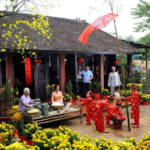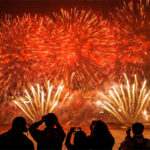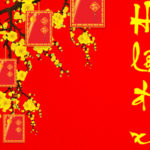The Tet holiday is a special time in Vietnamese culture, and one of the most distinctive traditions is the erection of a “cay neu” or New Year tree. But what is the significance of this custom, and why is it done? This article will delve into the fascinating history and meaning behind the cay neu, shedding light on this unique Vietnamese tradition.
1 The Legend of the Cay Neu
Long ago, when evil spirits roamed the land, they claimed ownership of all the fields and farms, forcing humans to rent the land and give up most of their produce. The spirits agreed to a deal where they would take the tops of the crops while humans took the stalks and roots. As rice was the main crop, this left humans with very little food.
 The Legend of the Cay Neu
The Legend of the Cay Neu
A kind fairy, disguised as an old man, advised the farmers to plant sweet potatoes, as the edible part grows underground. In response, the spirits changed their deal to “eating the roots and leaving the tops.” The fairy then suggested planting rice, which resulted in the spirits getting only the chaff, which was inedible.
Furious, the spirits demanded both the roots and the tops of the crops. The fairy gave the humans a new crop—a plant with fruits on the stalks and nothing edible at the roots or tops. Defeated, the spirits agreed to return all the land and forbid any cultivation.
The fairy and the humans then bargained for a piece of land equal to the shadow of a shirt hung from a bamboo tree. The spirits agreed, not realizing that the fairy would cast a spell to make the shadow grow larger and larger, eventually driving the spirits into the sea.
Determined to reclaim their land, the spirits prepared for battle. The fairy instructed the humans to attack with dog blood, pandan leaves, and garlic, which the spirits feared. The spirits were defeated and retreated to the East Sea. Before leaving, they begged the fairy to allow them to visit their ancestors during Tet. Out of compassion, the fairy agreed.
 The Cay Neu during Tet
The Cay Neu during Tet
Since then, during Tet, the spirits visit the land. To remind them of their promise, people erect the cay neu in front of their houses. The tree is decorated with wind chimes that create a gentle sound in the breeze, signaling the spirits to keep their distance.
Watch a video about the legend of the cay neu:

2 The Significance of the Cay Neu
The legend of the cay neu symbolizes the eternal struggle between good and evil, with the tree serving as a protector of peace and harmony for the Vietnamese people. During Tet, when the gods return to heaven, evil spirits may try to cause trouble, so the cay neu acts as a guardian against these forces. It is also believed to bring prosperity, good harvests, and peace for the coming year.
 Significance of the Cay Neu
Significance of the Cay Neu
The objects hung on the cay neu also hold symbolic value. The bamboo tree represents the yang element, while the round-shaped umbrella represents the yin element. The umbrella features five carps of different colors, representing the five elements: yellow in the center, white in the south, black in the north, green in the east, and red in the west.
3 When is the Cay Neu Erected and Taken Down?
In Vietnamese tradition, the cay neu is typically erected before Tet, the Vietnamese New Year. It is usually a 6-meter-tall bamboo tree decorated with wind chimes and other objects depending on regional customs.
The Kinh people erect the cay neu on the 23rd day of the twelfth lunar month. This is a time when guardian gods are believed to be absent, leaving homes vulnerable to evil spirits. Thus, the cay neu serves as a powerful symbol of protection.
Other ethnic groups have their own traditions, such as the Muong people, who plant the cay neu on the 28th of the twelfth lunar month, and the Hmong people, who erect it during a prayer festival from the 3rd to the 5th of the month. The day it is put up is called “le thuong neu” (upward cay neu), and the day it is taken down is called “le ha neu” (downward cay neu), which falls on the 7th day.
 Erection and Removal of the Cay Neu
Erection and Removal of the Cay Neu
4 What is Hung on the Cay Neu?
The decorations hung on the cay neu vary across regions but often include small bags of betel and areca nuts, and metal objects of various sizes.
 Decorations on the Cay Neu
Decorations on the Cay Neu
When the wind blows, these metal objects create a pleasant tinkling sound, believed to warn evil spirits that the house is occupied and off-limits. In some places, a lantern is also hung on the cay neu at night to guide the ancestors’ spirits back home for Tet. Traditionally, firecrackers were set off at the cay neu to welcome the new year and ward off evil.
5 The Cay Neu in Modern Times
Today, the cay neu has evolved beyond its traditional form. While it used to be strictly a bamboo tree, now any suitably tall tree can be used. The decorations have also become more diverse.
 The Cay Neu in Modern Times
The Cay Neu in Modern Times
Instead of the traditional wind chimes, betel and areca nuts, and pandan leaves, people now decorate the cay neu with red envelopes and other modern ornaments. These additions not only serve to ward off evil but also invite good luck and fortune.
6 How to Erect a Cay Neu
Creating a cay neu is quite simple. The bamboo tree used is typically old, tall, straight, and adorned with fresh leaves at the top. The top may also be decorated with pandan leaves to symbolize clouds. The trunk can be embellished with flags, lanterns, couplets, and wind chimes. At the base, a circle or arc of white lime powder is drawn, pointing outward toward the gate to ward off evil spirits.
 How to Erect a Cay Neu
How to Erect a Cay Neu
Unfortunately, the tradition of erecting a cay neu is fading in modern times. Many Vietnamese now see it merely as a decorative element during Tet, rather than understanding its deeper spiritual significance.
There is a folk poem about the cay neu that goes like this:
Cay da la dua treo kieu (cao)
Voi bot rac ngo chro treo moi nha
Quy vao thi Quy lai ra
Cay da la dua thi ta cua mồm
We hope that through this article, readers will gain a deeper understanding of the cay neu tradition and work to preserve this beautiful custom passed down by our ancestors.
Unveiling the Meaning Behind New Year’s Harvest: Tips for Having Luck in 2021
Celebrating the start of the New Year, many customs and traditions come together in a joyous expression of good fortune. From harvesting the new year’s fortune to praying for fortune and luck, the humanistic meaning behind these practices remains as relevant as ever. But what is the origin and how can we properly partake in the harvest of the new year? Read on to learn more about this fascinating custom.




































